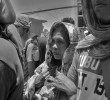There is irony in the festivities of Kaamulan going on. The plight of indigenous peoples continue to deteriorate. With large-scale mining, illegal logging, land-grabbing, aggressive agri-business expanding in many parts of Bukidnon, there will be no more gathering of tribes in the future to speak of. By destroying their land and heritage, we are destroying their future and our history.
By BEVERLY ANN S. MUSNI, YR.
Davao Today
Malaybalay, Bukidnon — In a frenzy of drumbeats and chants, Bukidnon’s Kaamulan festival is one of the most colorful, celebrated and recognized festivals in Mindanao and all over the country. With the province’s rich culture and heritage, the Kaamulan is a sight and sound to behold.
Kaamulan, which is held annually in Malaybalay City from the last part of February until mid-March, celebrates the life of seven tribes who originally inhabited the region, namely the Bukidnon, Higaonon, Talaandig, Manobo, Matigsalug, Tigwahanon and Umayamnon. From the root word “amul”, which means “to gather”, Kaamulan bring together these proud people to celebrate their unity. Whether be it a ritual for a datu (leader), a wedding ceremony, a peace pact or a thanksgiving ritual for a good harvest, the Kaamulan symbolizes peace, strength and unity among its people, as it recognizes their roots and culture as its heritage.
Yet, despite the celebration this festival conveys, the indigenous people of Bukidnon actually suffer most from attacks and harassment from the military and from land grabbing.
Since January, around 200 families from the Tigwahonon tribe in San Fernando, Bukidnon and the neighboring province of Kapalong, Davao del Sur, have been detained in their own village by the 8th Infantry Battalion.
The battalion, led by Col. Jose Maria Cuerpo, had turned the village into a concentration camp. They go to their usual procedure of arresting, detaining and torturing lumads in their counter-insurgency operations against the New People’s Army. Imagine the fear, hunger and isolation the Tigwahonons are experiencing, as they are blocked off by soldiers from their own farms and livelihood.
There have been reports of three people illegally arrested and detained, along with six cases of arson, indiscriminate bombings and economic blockade.
Last February 2, three tribe members were presented by the battalion to the media as members of the New People’s Army. Datu Magayla, Sayapo Maganyo and Totot Mansayloan were actually gagged, tortured and forced to go with the soldiers against their volition.
Targeting the innocent Lumads is an atrocity of the worst kind, a violation of the protocols of war by the Geneva Conventions and the Comprehensive Agreement on the Respect for Human Rights and International Humanitarian Law signed by both the Government of the Philippines (GPH) and the National Democratic Front (NDFP).
Such violations define the military as the Armed Forces of Pesters, who continue to employ worst tactics of war, which do not gain them support from the people for tormenting civilians and tagged them as rebels.
I observe that military operations come hand-in-hand with large-scale mining and other activities of plunder. In Dao, San Fernando, the San Christo Mines, an associate of Indo-Phil Resources-SMI-Xstrata Mining, holds a mining application in the area. It is no surprise that the military and paramilitary have come to the area like weeds to infest the ancestral areas of the Lumads. The paramilitary group in Dao, calling themselves as New Indigenous People’s Army Reform, is doing the military’s dirty work of attacking civilians who resist the large-scale mining company’s entry. They are responsible for the killing of Dao’s barangay captain Jimmy Liguyon, who is a Matigsalug who led the community’s resistance to large-scale mining.
There is irony in the festivities of Kaamulan going on. The plight of indigenous peoples continue to deteriorate. With large-scale mining, illegal logging, land-grabbing, aggressive agri-business expanding in many parts of Bukidnon, there will be no more gathering of tribes in the future to speak of. By destroying their land and heritage, we are destroying their future and our history.
Mindanaoans are proud people. We take pride in our culture and our heritage. We derive strength from our history as one of the strongest people, resisting colonialism since Spanish times as evidenced by the indigenous peoples and the Moro people. The Kaamulan festival is a symbol of that pride. And because of that pride, we should always remember that we should gather to stand up against industrial expansion and plunder guised as development.
To come together with the indigenous peoples for their rights, for their ancestral land, for the environment, and oppose military atrocities and environment plunder, that I think is the essence of Kaamulan. (Beverly Ann S. Musni, Yr., davaotoday.com)

![[STANDPOINT] Illegal drugs and the NIMBY mindset](https://davaotoday.com/wp-content/uploads/2016/09/Mags-Maglana_UPMIN-Sept.-20-110x100.jpg)








